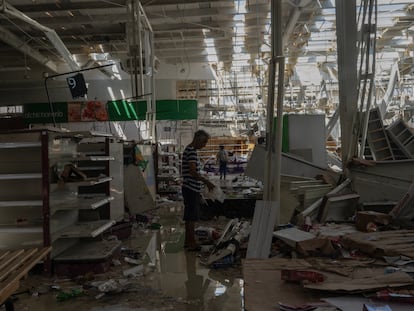Acapulco struggles to recover: Mexican Open tennis tournament being held amidst violence and deprivation caused by Hurricane Otis
The city is undergoing reconstruction and the inhabitants are still relying on government aid while the sporting event promotes tourism
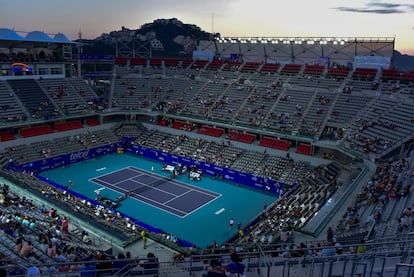

People say that crises bring opportunities. Many imagined a new-look Acapulco following the devastation of Hurricane Otis, an apocalypse that would usher in peace through the reconstruction of the city, or so the most optimistic people thought. However, the calm has not followed the storm, at least not yet. During these days, in which the battered pearl of the Pacific is staging the Mexican Tennis Open as a symbol of the yearned-for normality, all is still not well in the region. There are still long queues in supermarkets to exchange the vouchers issued by the government for food before they expire and many of those affected are waiting to be censused to receive the expected aid. Violence has resulted in various deaths in the last week alone, with the customary scenario of bodies shot to death or severed heads accompanied by narco-messages. Public and private transportation has ceased to operate on several occasions in protest against the attacks perpetrated by organized criminal groups. In the meantime, the governors have hailed the big Latin American tennis event with grandiose phrases: “The port lives, shines and will shine stronger than ever. We want a new Acapulco,” recently exclaimed the governor, Evelyn Salgado.
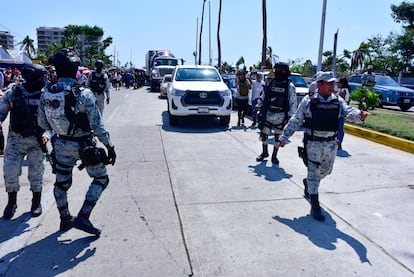
Hoteliers still estimate that it will take two years before they can run at full capacity, given the extent of the destruction caused by the hurricane that swept in from the sea in the early hours of October 26. Health officials are working tirelessly to bring to an end as soon as possible the dengue epidemic that caused the collapse of the health services. Acapulco is still struggling to get back on its feet, which is why the tennis tournament, hosted in the city since 2001, represents two sides of the coin. On the one hand, it is an opportunity to stimulate tourism and employment. On the other, it is evidence that basic needs and outbreaks of violence cannot be camouflaged with a sporting showcase.
“The Open only provides Acapulco with publicity. This year, the state government has earmarked 20 million pesos for its organization, but in reality it only benefits the people who are in its immediate environment,” says Óscar Ricardo Muñoz Cano, journalist of El Sur de Guerrero newspaper, over the phone. He says that there are around 11,000 families who benefit from the tennis, those who work in hotels, transportation, and so forth, but that the attendees are foreigners because there is not enough wealth in Acapulco for residents to afford the cost of the tickets. “In addition, practically everything is consumed indoors, in the enclosure, they do not usually go outside, they do not coexist,” by that he means the money they spend does not go far beyond the tennis courts in the enclosure. However, the players have had kind words of good fortune for Acapulco, and Stefanos Tsitsipas has promised to donate $1,000 for every ace he racks up. We can only wish him luck.
Days after the houses were swept away, the palm trees lay on the beach and the streets, the hotels were left with the bare skeleton of their structure and 56 lives were lost in the catastrophe (there are still many missing that may have been dragged down by the sea), there was still solidarity in the midst of the looting and plundering. The first weeks of devastation subsided and last Sunday, the navy announced that it was closing its collection centers from which it had supplied the population with basic goods and food, but the supply has not yet returned to normal and the reconstruction aid is not getting to everyone. Some of those affected attempted to block roads in protest because they were not being censused, and therefore did not receive what they were entitled to, they protested.
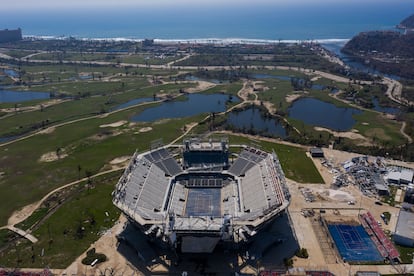
Around 10,000 national guards were assigned to the area at the time. Acapulco was already a barbaric region where organized crime had been gaining influence over the juicy profits from tourism, including drugs and prostitution, for years. The city lost its past splendor and the celebrities secluded themselves in certain privileged areas along the coast. The others left for other vacation destinations. Violence was becoming visible every afternoon, in full daylight. Hundreds of tourists, many arriving from the Mexican capital, looked on in astonishment as gunmen entered a local restaurant and killed a waiter, as an example. The deployment of the military on the beaches, uniformed and armed, had little effect, as they provided an unusual photo opportunity for beachgoers.
Perhaps nothing can stop crime. People thought at first, the hurricane that devastated the city would drive the corrupt narcos out of Acapulco and the community could rebuild itself with other social parameters. But this was not the case. The assassinations have been ongoing and there are many who believe that the economic gains from the reconstruction will provide a lifeline for the gang members and their diverse circle, which sometimes involves politics and the business sector. The crisis of violence in the transport sector certainly includes some of this. “We thought that with Otis’ battering they would have no one to extort money from, all the businesses closed, but they have targeted the transport sector,” says the journalist Muñoz Cano. Indeed, the mafias that fight over transportation have triggered numerous crises in Acapulco and the whole state of Guerrero, causing deaths and placing the state government in a complex situation. Burned taxis, murdered drivers. The state responds to each crisis by pledging to provide more police to reinforce the routes, but nothing can deter crime.
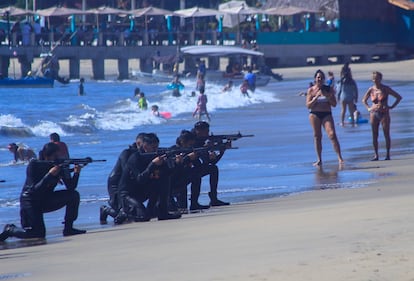
“We are still in trouble. Here we are doing what we can for the reconstruction, but private and public resources are not enough, they want to make out that we are fine, that they are opening hotels, but the most emblematic ones, such as the Princess or the Mundo Imperial are at 50%. The statistics include the very old, small guesthouses where groups of young people stay,” says Muñoz Cano. And he goes on to mention intermittent transport stoppages, violence and food aid. On a scale of 0 to 10? “Acapulco has always been a six or seven. What we have is resilience.”
In the last few days, the local news reported that the stolen mariachi frogs were recovered and were singing again. This news and the Tennis Open are the things to be most optimistic about in the area at present.
Sign up for our weekly newsletter to get more English-language news coverage from EL PAÍS USA Edition
Tu suscripción se está usando en otro dispositivo
¿Quieres añadir otro usuario a tu suscripción?
Si continúas leyendo en este dispositivo, no se podrá leer en el otro.
FlechaTu suscripción se está usando en otro dispositivo y solo puedes acceder a EL PAÍS desde un dispositivo a la vez.
Si quieres compartir tu cuenta, cambia tu suscripción a la modalidad Premium, así podrás añadir otro usuario. Cada uno accederá con su propia cuenta de email, lo que os permitirá personalizar vuestra experiencia en EL PAÍS.
¿Tienes una suscripción de empresa? Accede aquí para contratar más cuentas.
En el caso de no saber quién está usando tu cuenta, te recomendamos cambiar tu contraseña aquí.
Si decides continuar compartiendo tu cuenta, este mensaje se mostrará en tu dispositivo y en el de la otra persona que está usando tu cuenta de forma indefinida, afectando a tu experiencia de lectura. Puedes consultar aquí los términos y condiciones de la suscripción digital.
More information
Archived In
Últimas noticias
Welcome to the post-religion era: The idea of Christianity as the absolute truth has become obsolete
‘I thought you would like it’: The risky sexual practice popularized by TV shows and TikTok
The digitalization of tourism: ‘They promise experiences and gave us the worst possible one’
Mexican peso defies uncertainty with forecasts of a new period of stability in 2026
Most viewed
- Sinaloa Cartel war is taking its toll on Los Chapitos
- Oona Chaplin: ‘I told James Cameron that I was living in a treehouse and starting a permaculture project with a friend’
- Reinhard Genzel, Nobel laureate in physics: ‘One-minute videos will never give you the truth’
- Why the price of coffee has skyrocketed: from Brazilian plantations to specialty coffee houses
- Silver prices are going crazy: This is what’s fueling the rally
